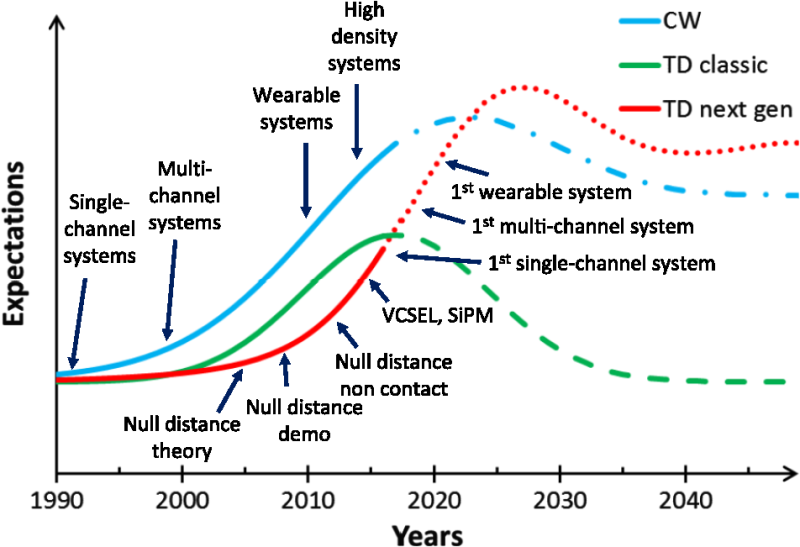Light combined with time-based data sees more deeply inside the body

New light-based technologies that facilitate a look inside the human body using light—and without cutting into the tissue—promise to enable both compact, wearable devices for point-of-care diagnostics as well as powerful new systems that provide even more information and from even deeper under the skin.
Recent work and visionary future directions are detailed in a new open-access article by Antonio Pifferi and colleagues at the Politecnico di Milano and Istituto di Fotonica e Nanotechnologie CNR published in the Journal of Biomedical Optics by SPIE, the international society for optics and photonics.
The article is part of a special section on Clinical Near-Infrared Spectroscopy and Imaging under Guest Editors Marco Ferrari (Università degli Studi dell'Aquila), Joseph Culver (Washington University School of Medicine in St. Louis), Yoko Hoshi (Tokyo Metropolitan Institute of Medical Science), and Heidrun Wabnitz (Physikalisch-Technische Bundesanstalt).
The desirability of noninvasively probing human tissues and their functions has sparked new physical concepts, theoretical models, instruments, measurement approaches, and applications, note the authors in "New frontiers in time-domain diffuse optics."
We are at the dawn of the next generation of time-domain systems, with a breakthrough in performance, size, cost, and flexibility that has the potential for great impact on new and widespread applications, the authors assert. This breakthrough is enabled by impressive advancements in single-photon detection boosted by high-energy physics and positron-emission tomography systems.
In diffuse optical imaging, light is injected into the surface of a medium, such as the body. The light signal is re-emitted elsewhere on the surface and analyzed as to how it has changed. The analysis yields information about the chemical composition of the tissues, their densities, and other aspects.
The simplest methods compare continuous-wave properties of the original signal and the re-emitted light.
Systems that also analyze frequency or time changes in the light signal provide additional data. Current state-of-the-art methods use technologies that enable time-to-digital conversion of the signal, providing even more detail.
Wearable time-domain devices already have been developed for continuous-wave systems, enabling studies in breast cancer detection, brain mapping, muscle monitoring, and noninvasive assessment of lipids, bone, and collagen. Time-domain techniques have also been used in nondestructive characterization of food, wood, pharmaceuticals, and semiconductor powers.
Over the next 20 years researchers envision that such systems will become smaller, making feasible their integration into wearable devices, and smarter, increasing their overall accuracy in detecting and identifying tissue components.
Future devices could be used in brain monitors or muscle oximeters, even for in vivo detection of the brain function during motor or cognitive tasks.
"What makes the future technology unique is its potential to probe noninvasively and in greater depth into human functions and chemical composition, yet with simple personal appliances usable at home and compatible with normal life," Pifferi said. Currently unreachable organs and functions would be accessible, including the heart.
Quite surprisingly, Pifferi noted, after the thermometer and the blood pressure meter, not many other diagnostic devices for personal healthcare have been brought into the home.
"The new smart sensors, interacting in the ambient environment and transmitting hidden internal information over the cloud, will populate the Internet of Things to the benefit of clinical, industrial, and consumer-level applications," he said.
"Over its 20 years devoted to promoting of the use of light for human diagnostics, the Journal of Biomedical Optics has witnessed the evolution of such systems towards portable, compact clinical instruments," said Ferrari, a pioneer of clinical near-infrared spectroscopy, including early time-domain spectral measurements on the human forearm. "Over the next 20 years we will likely enable a still greater revolution with the shrinking of in-depth detection capabilities into miniaturized smart optodes, each more powerful than a single instrument of today."
Research moves on the one hand towards complexity, he noted, with hundreds or thousands of smart optodes to explore brain connectivity, the basis of brain behavior and many neurological disorders.
At the same time, Ferrari said, "Work is also progressing toward providing a simple, wearable sensor to aid psychologists and neurophysiologists in understanding human behavior on many levels, in real-life environments and stimuli."
More information: Antonio Pifferi et al, New frontiers in time-domain diffuse optics, a review, Journal of Biomedical Optics (2016). DOI: 10.1117/1.JBO.21.9.091310
Journal information: Journal of Biomedical Optics
Provided by SPIE



















